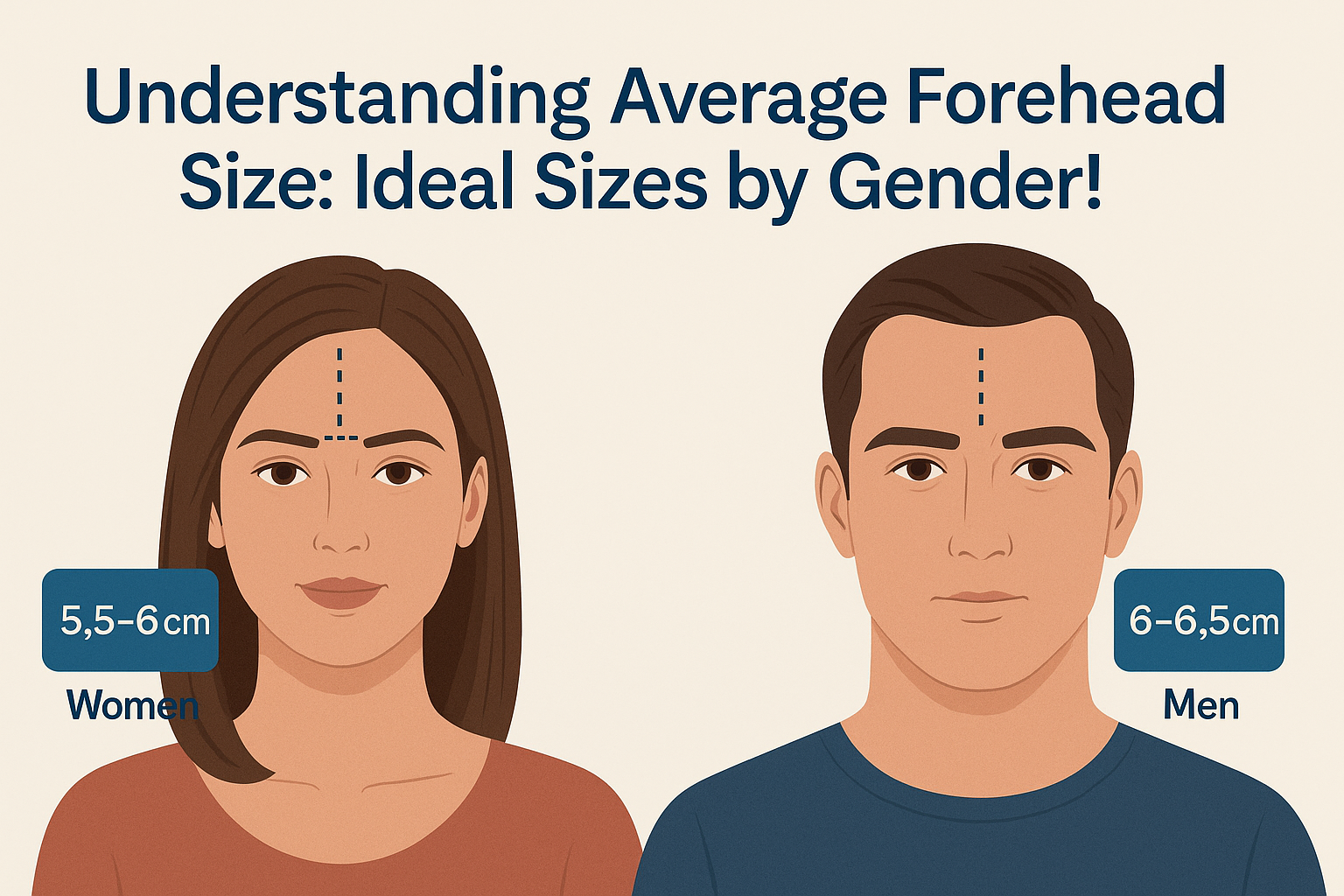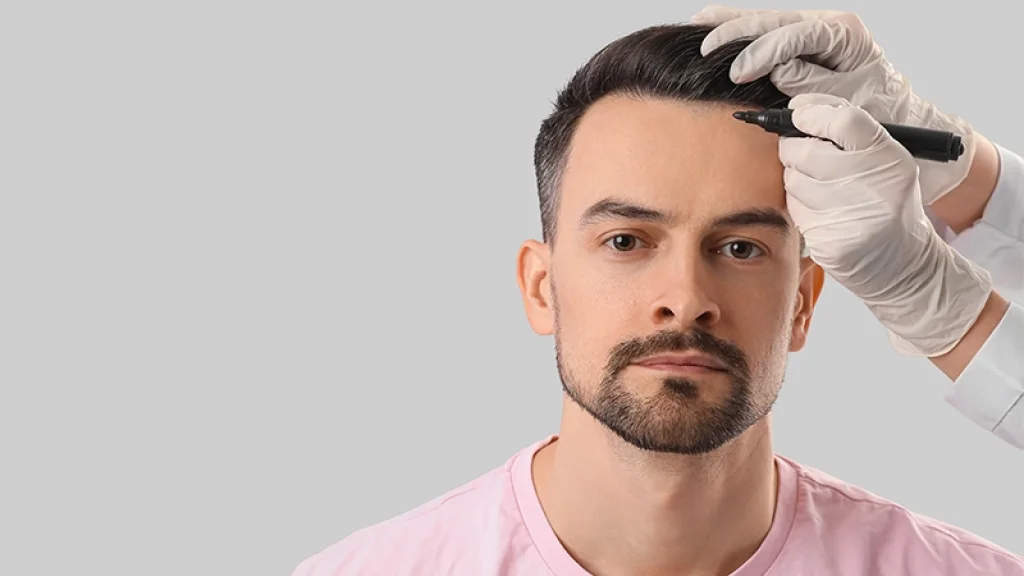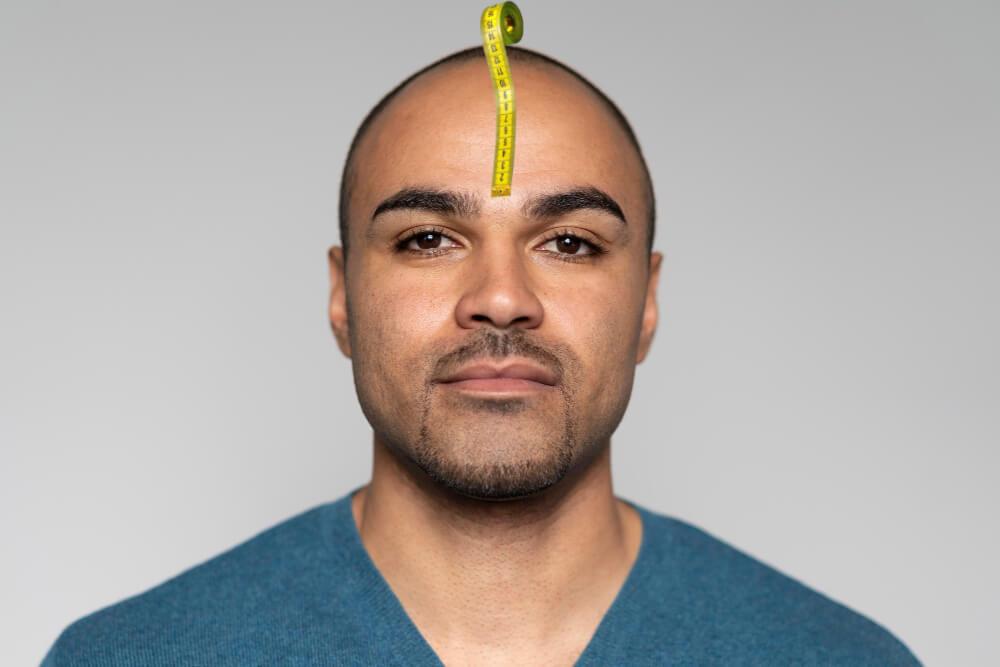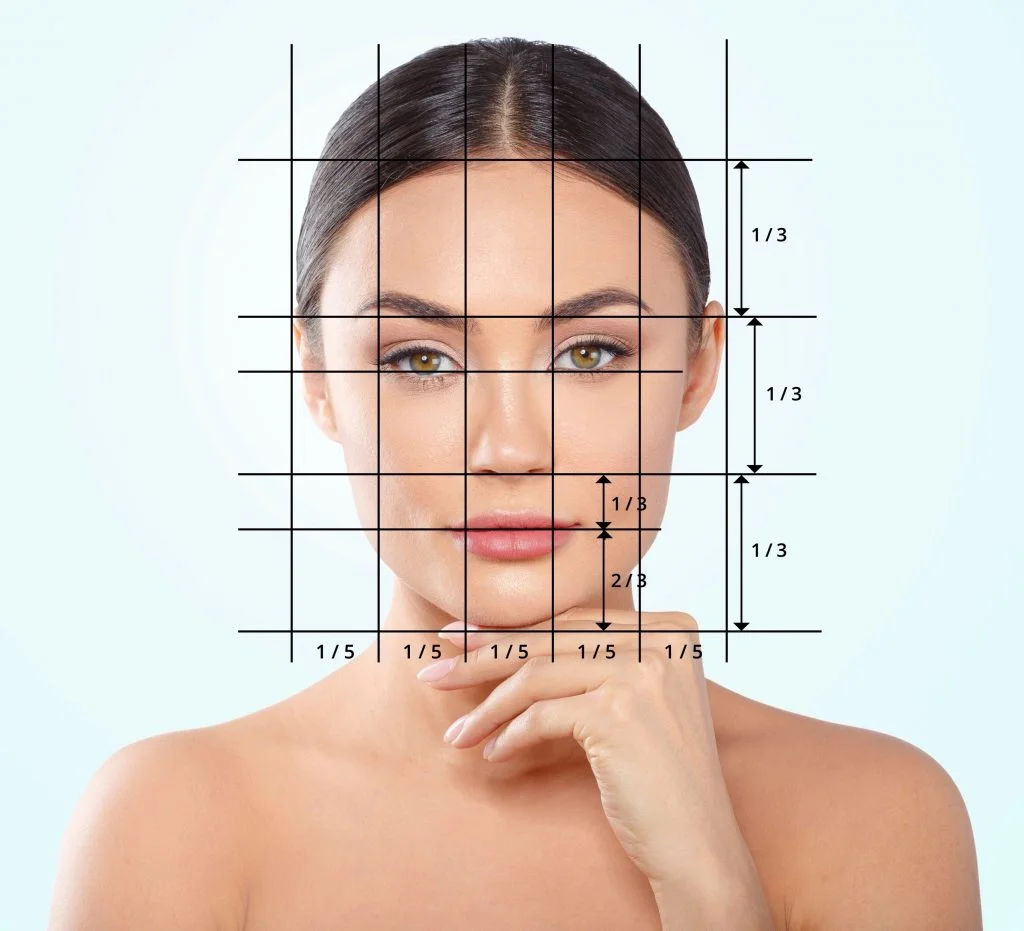
When people think about facial beauty, most immediately focus on features such as the eyes, lips, or jawline. Yet, one element that significantly shapes overall appearance often goes unnoticed: the forehead. The size and proportion of the forehead have a direct impact on how balanced, youthful, and attractive a face looks.
For some, the forehead feels too high, giving the impression of a “five-head.” For others, it may appear small and compressed, making facial harmony difficult to achieve. Patients regularly ask us at Hair Legends Antalya:
- “What is the normal forehead size for men and women?”
- “Is my forehead considered too big?”
- “Can I change the size of my forehead without surgery?”
This blog will provide a complete guide to forehead proportions. We will discuss:
- The average forehead size across genders and populations,
- What the “ideal” measurements are according to aesthetic principles,
- How factors such as genetics, age, and hairline recession change forehead size,
- The latest solutions—from hair transplants to eyebrow adjustments—available at Hair Legends Antalya.
By the end, you will understand not only whether your forehead is within the “normal” range but also how modern cosmetic and medical techniques can harmonize your appearance.
What Is the Average Forehead Size?

Measuring the Forehead
The forehead is measured in two directions:
- Vertical height: From the midpoint of the eyebrows to the start of the hairline.
- Horizontal width: From one temple to the other.
While horizontal width is important, vertical height is most often discussed when people talk about “big” or “small” foreheads.
Average Sizes for Men and Women
- Men: 5.8–6.5 cm vertical height.
- Women: 5.5–6.2 cm vertical height.
- Horizontal width: Often proportional to the cheekbone distance, usually 12–14 cm.
Forehead Across Populations
Anthropological studies show variation in forehead size across ethnic groups:
- East Asians: Typically shorter, flatter foreheads.
- Europeans: Taller foreheads with curved profiles.
- Africans: Often broader foreheads with stronger bone structure.
Historical Perceptions
Interestingly, the ideal forehead has changed throughout history:
- Ancient Greece: Large foreheads associated with wisdom.
- Renaissance Europe: Women plucked hairlines to artificially enlarge foreheads.
- Modern Times: Balanced proportions are valued over extremes.
Ideal Forehead Sizes by Gender
Men’s Ideal Forehead

- Average ideal height: 6–6.5 cm.
- A strong, slightly higher forehead with a square hairline is considered masculine.
- M-shaped or mature hairlines are common and not necessarily unattractive.
Women’s Ideal Forehead

- Average ideal height: 5.5–6 cm.
- A soft, rounded hairline gives a feminine and youthful appearance.
- Women with hairlines lower than average are perceived as having more delicate facial harmony.
The Rule of Thirds
In facial aesthetics, the “rule of thirds” divides the face into equal vertical sections:
- Hairline to eyebrows,
- Eyebrows to nose base,
- Nose base to chin.
If the forehead takes up more than one-third, the face may appear unbalanced. Conversely, if it is too short, the face may look compressed.
What Affects Forehead Size?
Genetics
Forehead size is primarily determined by genetics. If one or both parents have a high hairline, chances are their children will too. Genetic predisposition also dictates whether someone will experience early hairline recession.
Hairline Position
The position of the hairline is the single biggest factor in forehead size.
- A high hairline enlarges the forehead.
- A low hairline reduces forehead size, sometimes to the point of looking compressed.
Age & Hair Loss
With age, the hairline naturally recedes, especially in men. This makes the forehead appear taller. Women may not recede in the same pattern but often experience diffuse thinning that can increase scalp visibility.
Gender Differences
- Men: Prone to M-shaped or U-shaped recession.
- Women: More likely to have diffuse thinning with a stable hairline.
Medical Factors
- Endocrine disorders (thyroid issues, PCOS).
- Autoimmune conditions (Alopecia Areata).
- Medications such as chemotherapy can drastically change forehead proportions.
Large vs. Small Foreheads
Large Forehead
- Causes: Genetics, high hairline, hair loss, or surgical history.
- Perceptions: Historically linked to intelligence, but today often associated with imbalance.
- Psychological Impact: Patients with large foreheads sometimes avoid hairstyles exposing the forehead.
Small Forehead
- Causes: Naturally low hairline, eyebrow positioning, or short skull shape.
- Perceptions: Can make the face look compressed, sometimes creating a “crowded” appearance.
- Psychological Impact: Some patients feel their face lacks sophistication or maturity.
Gender Differences
- Women are more likely to feel self-conscious about large foreheads.
- Men often worry about receding foreheads, interpreting them as a sign of aging.
Medical & Cosmetic Solutions
Modern cosmetic medicine offers multiple ways to adjust the appearance of forehead size. Some are surgical, some are minimally invasive, and some involve simple styling choices.
Hair Transplant to Lower the Hairline
- Best for: Patients with high foreheads due to genetic hairline or male pattern baldness.
- Techniques:
- Sapphire FUE: Follicles harvested individually and placed with sapphire blades, ensuring minimal scarring.
- DHI (Direct Hair Implantation): Follicles implanted directly using a Choi Pen, ideal for detailed hairline work.
- Benefits:
- Permanent results.
- Natural look with customized design.
- Non-invasive compared to surgical forehead reduction.
- At Hair Legends Antalya: Hairline design is performed according to golden ratio principles, ensuring proportional harmony.
Eyebrow Transplant
- High-set eyebrows can exaggerate forehead size. By lowering or thickening the brows:
- The forehead appears smaller.
- The eyes gain more definition.
- Performed using FUE or DHI with natural results.
Forehead Reduction Surgery
- Involves surgically removing a strip of skin from the upper forehead and advancing the hairline.
- Pros: Immediate reduction.
- Cons: More invasive, risk of scarring, limited in how much can be reduced.
- Many patients prefer hair transplant due to naturalness.
PRP & Exosome Therapy
- PRP (Platelet-Rich Plasma) strengthens thinning hair, making the hairline appear denser.
- Exosomes deliver growth factors to regenerate follicles.
- These treatments cannot lower the hairline but can reduce scalp visibility, visually balancing forehead size.
Non-Surgical Adjustments
- Botox: Adjusts eyebrow height, slightly altering proportions.
- Dermal Fillers: Can contour temples to harmonize face width.
- Hairstyles: Fringes, bangs, or layered cuts soften a large forehead.
Case Studies from Hair Legends Antalya
Case Study 1: Male Patient, UK
- Age: 32
- Forehead height: 7.2 cm (above average).
- Treatment: 3,000 graft Sapphire FUE lowering the hairline by 1.2 cm.
- Result: Restored balance, masculine square hairline.
- Patient feedback: “I no longer avoid photos. My forehead looks normal again.”
Case Study 2: Female Patient, Spain
- Age: 27
- Concern: Genetic high forehead since childhood.
- Treatment: 2,400 graft DHI lowering hairline by 1.5 cm.
- Result: More feminine, softer look; forehead now 5.8 cm.
- Patient feedback: “This small change made my whole face look balanced.”
Case Study 3: Exosome Therapy, Germany
- Age: 41, male.
- Concern: Diffuse thinning, scalp visible, forehead looked enlarged.
- Treatment: 2 sessions exosome therapy + PRP.
- Result: Thicker hair density, reduced scalp visibility. Forehead looked smaller without surgery.
Lifestyle & Perception Tips
Not all forehead concerns need medical treatment. Lifestyle, styling, and grooming choices can also influence how the forehead looks.
Hairstyles for Large Foreheads
- Men: Textured fringe, crew cut, Caesar cut.
- Women: Side-swept bangs, curtain bangs, layered cuts.
Hairstyles for Small Foreheads
- Men: Longer quiffs, slicked-back styles.
- Women: Ponytails, buns that elongate the face.
Makeup Adjustments
- Highlighting: Applying lighter tones below the hairline can shorten forehead visually.
- Contouring: Using darker shades at hairline edges reduces perceived height.
Daily Care
- Use sunscreen on the forehead to prevent early aging lines.
- Avoid traction hairstyles that may pull back the hairline.
- Massage the scalp to improve blood flow and follicle health.
Why Antalya Is the Perfect Destination
World-Class Clinics
Antalya is home to internationally recognized clinics like Hair Legends, equipped with modern technology and expert surgeons specializing in hairline design.
Affordable Packages
- Costs are typically 60–70% lower than in the UK, Germany, or the US.
- All-inclusive packages cover hotel accommodation, transfers, and aftercare.
Multilingual Patient Care
At Hair Legends Antalya, coordinators speak English, German, Spanish, French, making the process stress-free.
Medical Tourism Infrastructure
Antalya combines medical excellence with tourism:
- Luxury hotels for recovery.
- Beaches and cultural attractions for relaxation.
- International airport with direct flights from Europe.
Proven Track Record
Thousands of patients travel to Antalya each year for hairline correction, making it one of the top global destinations for forehead proportion adjustments.
Extended FAQ (People Also Ask)
Q1: What is considered a big forehead?
Anything above 6.5–7 cm for men and 6.2 cm for women.
Q2: Can forehead size be reduced without surgery?
Yes, with hair transplants or eyebrow transplants.
Q3: How many grafts are needed to lower the hairline?
Usually 2,000–3,500 depending on the area.
Q4: Do women get hairline transplants?
Yes, many women in Antalya choose it to reduce forehead height.
Q5: Are results permanent?
Yes, transplanted follicles are resistant to balding.
Q6: How long is recovery after transplant?
7–10 days for healing, full results within 9–12 months.
Q7: Is forehead reduction surgery better than transplant?
Transplants are safer, more natural, and less invasive. Surgery carries risks of scarring.
Q8: Can PRP alone reduce forehead size?
No, but it strengthens existing hair to reduce scalp visibility.
Q9: Will lowering my forehead change my expressions?
No, hair transplant only affects follicles above muscles.
Q10: Can I combine hairline lowering with eyebrow transplant?
Yes, it’s often recommended for maximum harmony.
Q11: What’s the cost of forehead reduction in Antalya?
Packages are around one-third of European prices.
Q12: Is a large forehead unattractive?
Not necessarily. Balance with other facial features matters more than exact size.
Q13: At what age should I consider hairline lowering?
From mid-20s, once hair loss pattern stabilizes.
Q14: Does a hair transplant hurt?
With local anesthesia, pain is minimal. Mild soreness disappears in days.
Q15: Can hairstyles alone fix forehead concerns?
They can help, but permanent correction comes from medical solutions.
Why Choose Hair Legends Antalya
- Expertise in artistic hairline design.
- Advanced Sapphire FUE & DHI techniques.
- Full VIP packages: hotel, transfers, aftercare.
- Multilingual support for international patients.
- Proven success with patients from the UK, Germany, Spain, and the Middle East.
Conclusion
Your forehead size may seem like a fixed trait, but modern cosmetic medicine proves otherwise. Whether your concern is a high forehead, a receding hairline, or imbalance between facial thirds, solutions exist.
From hair transplants that lower the hairline permanently, to eyebrow transplants and non-surgical therapies, you can achieve harmony and confidence.
At Hair Legends Antalya, we combine medical precision with artistic vision, guided by golden ratio aesthetics. Our mission is to help you look natural, balanced, and confident.
📩 Contact Hair Legends Antalya today for a free online consultation and discover how we can harmonize your forehead size with world-class treatments.
